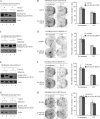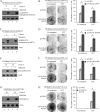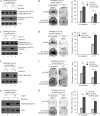Characterization of functional domains necessary for mutant p53 gain of function
- PMID: 20212049
- PMCID: PMC2863234
- DOI: 10.1074/jbc.M109.097253
Characterization of functional domains necessary for mutant p53 gain of function
Abstract
Tumor cells, including SW480 carcinoma cells that carry a mutant p53, are addicted to the mutant for their survival and resistance to growth suppression by chemotherapeutic agents. Here, we investigated whether various classes of p53 mutants share a common property and functional domains necessary for mutant p53 gain of function. To test this, we generated SW480 cell lines in which endogenous mutant R273H/P309S can be inducibly or stably knocked down, whereas a small interfering RNA-resistant mutant p53 along with a mutated functional domain can be inducibly or stably expressed. We found that both contact-site (R248W and R273H) and conformation (G245S and R249S) mutants are able to maintain the transformed phenotypes of SW480 cells conferred by endogenous mutant p53. We also found that activation domains 1-2 and the proline-rich domain are required for mutant p53 gain of function. Interestingly, we showed that the C-terminal basic domain, which is required for wild-type p53 activity, is an inhibitory domain for mutant p53. Furthermore, we showed that deletion of the basic domain enhances, whereas a mutation in activation domains 1-2 and deletion of the proline-rich domain abolish mutant p53 to regulate Gro1 and Id2, both of which are regulated by and mediate endogenous mutant p53 gain of function. These results indicate that both conformation and contact-site mutants share a property for cell transformation, and the domains critical for wild-type p53 tumor suppression are also required for mutant p53 tumor promotion. Thus, the inhibitory basic domain and the common property for p53 mutants can be explored for targeting tumors with mutant p53.
Figures









Similar articles
-
Suppression of inhibitor of differentiation 2, a target of mutant p53, is required for gain-of-function mutations.Cancer Res. 2008 Aug 15;68(16):6789-96. doi: 10.1158/0008-5472.CAN-08-0810. Cancer Res. 2008. PMID: 18701504 Free PMC article.
-
Identification of GRO1 as a critical determinant for mutant p53 gain of function.J Biol Chem. 2009 May 1;284(18):12178-87. doi: 10.1074/jbc.M900994200. Epub 2009 Mar 3. J Biol Chem. 2009. PMID: 19258312 Free PMC article.
-
P53-R273H mutation enhances colorectal cancer stemness through regulating specific lncRNAs.J Exp Clin Cancer Res. 2019 Aug 28;38(1):379. doi: 10.1186/s13046-019-1375-9. J Exp Clin Cancer Res. 2019. PMID: 31455383 Free PMC article.
-
Mutant p53 in Cancer: Accumulation, Gain-of-Function, and Therapy.J Mol Biol. 2017 Jun 2;429(11):1595-1606. doi: 10.1016/j.jmb.2017.03.030. Epub 2017 Apr 6. J Mol Biol. 2017. PMID: 28390900 Free PMC article. Review.
-
Targeting the Oncogenic p53 Mutants in Colorectal Cancer and Other Solid Tumors.Int J Mol Sci. 2019 Nov 28;20(23):5999. doi: 10.3390/ijms20235999. Int J Mol Sci. 2019. PMID: 31795192 Free PMC article. Review.
Cited by
-
The consequence of oncomorphic TP53 mutations in ovarian cancer.Int J Mol Sci. 2013 Sep 23;14(9):19257-75. doi: 10.3390/ijms140919257. Int J Mol Sci. 2013. PMID: 24065105 Free PMC article. Review.
-
Mutant p53 disrupts MCF-10A cell polarity in three-dimensional culture via epithelial-to-mesenchymal transitions.J Biol Chem. 2011 May 6;286(18):16218-28. doi: 10.1074/jbc.M110.214585. Epub 2011 Mar 22. J Biol Chem. 2011. PMID: 21454711 Free PMC article.
-
Gain-of-function mutant p53: history and speculation.J Mol Cell Biol. 2019 Jul 19;11(7):605-609. doi: 10.1093/jmcb/mjz067. J Mol Cell Biol. 2019. PMID: 31283823 Free PMC article. Review. No abstract available.
-
Histone deacetylase inhibitors suppress mutant p53 transcription via histone deacetylase 8.Oncogene. 2013 Jan 31;32(5):599-609. doi: 10.1038/onc.2012.81. Epub 2012 Mar 5. Oncogene. 2013. PMID: 22391568 Free PMC article.
-
Mutant p53 in cancer: new functions and therapeutic opportunities.Cancer Cell. 2014 Mar 17;25(3):304-17. doi: 10.1016/j.ccr.2014.01.021. Cancer Cell. 2014. PMID: 24651012 Free PMC article. Review.
References
Publication types
MeSH terms
Substances
Grants and funding
LinkOut - more resources
Full Text Sources
Medical
Research Materials
Miscellaneous

